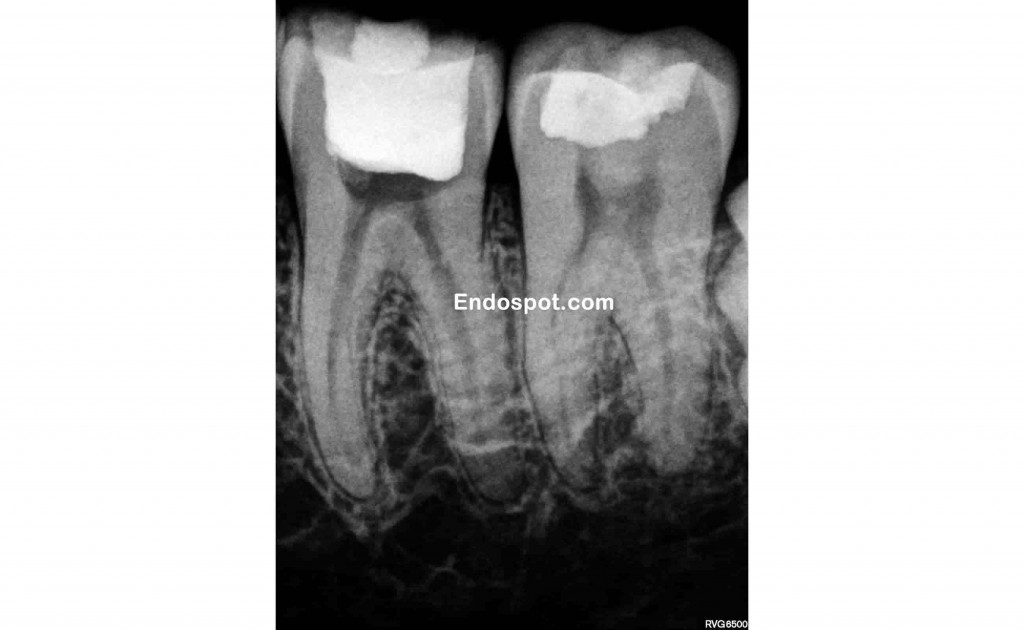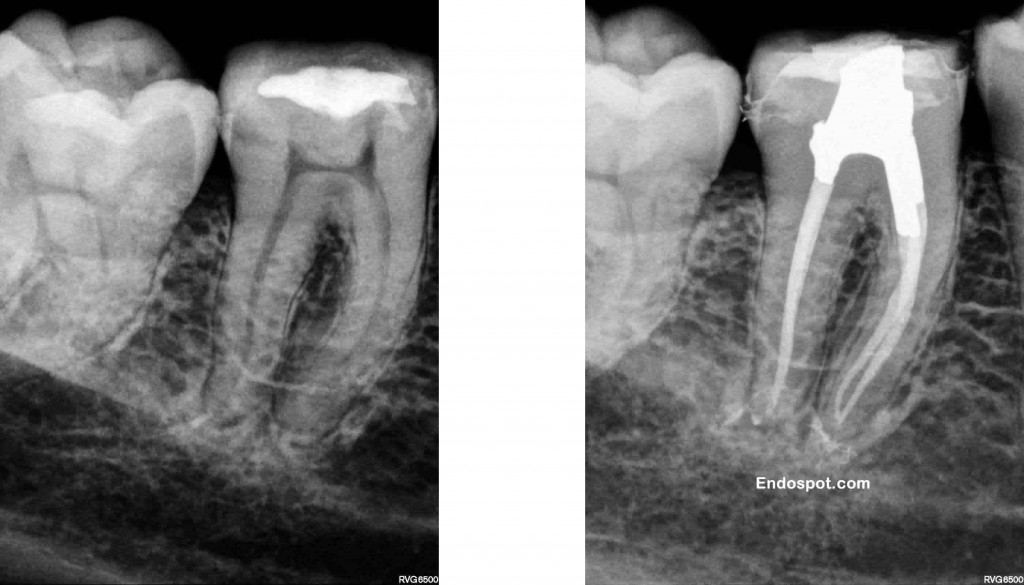I had the opportunity during the Australian Dental Association Congress to get my hands on the new Self Adjusting File. It’s not yet available for purchase in Australia, but will be in a couple of months. The SAF comes in 21, 25, 31mm lengths and two widths.

The three lengths of the Self Adjusting File
To be honest, there is a lot of cynicism out there amongst Endodontists regarding this instrument, mainly because of the manufacturer’s claim that you only require one SAF file to prepare the canal. I think some of the cynicism is driven by the fact that both Dentsply and VDW have recently released their own single file reciprocating systems. The cynicism of Endodontists regarding single file systems is warranted in my opinion. Realistically no one single round file is going to be adequately able to clean and shape the complex anatomy that we are faced with in root canals. They may also force the heavily infected contents of the coronal part of the canals apically and they may not give sufficient time and bulk of irrigant to allow cleansing. When you read the fine print. even the manufacturers will admit that certain canals with particular anatomy preclude the use of the reciprocating files.
In the case of the SAF, the manufacturer told me that they were not selling the system as something that will make preparation easier, cheaper or faster, but rather increase the quality of the preparation. This is probably a good line to take if you want acceptance by the Endodontic community.
OK, on to the SAF. Basically, the file is made of a NiTi mesh with a coating that is designed to “sandpaper” the walls of the canal. The mesh compresses to fit the shape of the canal. I admit I thought the engineering concept behind the file was pretty cool. The manufacturer told me that the designer was involved in the production of cardiac stents and utilised the basic design concept of these. I made the short video below to give you an idea of how the file behaves.
httpv://www.youtube.com/watch?v=UGZZP6_vtN0
On using the file, my first impression is that I’m not going to be out of a job as an Endodontist due to the release of the SAF. You still need to find the canals and prepare to a size 20 at the apex before using it. If you don’t prepare a path, then you’ll end up blocking the canal with debris, just like can be done with rotary files. That said, the ability of the file to prepare these irregular plastic shaped blocks was impressive. The block has an oval shaped canal with fins in it and a fine red coating on the inside. In a one minute session, the file pretty much cleaned all the red stuff off the inside.
I took one of these blocks back to my surgery to see how well I could clean it using traditional methods and after about four minutes of using rotary Ni Ti, hand files, and ultrasonic files, I still couldn’t get the block as clean as I did with the SAF. I’m not sure how well the apical part of the preparation was phycially cleaned by the SAF. If I was using the SAF, I think I’d probably end up gauging the apical portion after using SAF and maybe finishing off with rotary files to enlarge it if required.

Plastic block prepared by rotary NiTi on the right and SAF on the left. I took this image from the manufacturer's online powerpoint presentation, but it mirrors the experience I had.
There are two aspects to the SAF system. The first is the ability of the file to clean, and the second is the fact that it is constantly pumping fresh NaOCl through the centre of the file. It may well be that this is the most useful/best aspect of the system. Often in our literature and certainly by manufacturers an improperly greater emphasis is placed on the mechanical preparation of root canals systems compared to our efforts to actually clean the canals of tissue and microorganisms. In a previous post I’ve mentioned the benefits of passive ultrasonic irrigation, and I think the continual deposition of fresh NaOCl into the canal during preparation has great potential.
There isn’t really much research available on the SAF. I could find seven papers in pubmed, all bench top studies (see the end of this post for a complete list). The general outcome of these is that the SAF does a reasonably good job of debriding most areas of the canals under the conditions of the studies, and some nice microCT images were produced. One study (remember these are in vitro, not in actual clinical situations) found the SAF was significantly better at disinfecting canals infected with e. faecalis than rotary NiTi (Siquiera Jr et al. 2010). I guess we need to see more research and time will tell if the SAF is able to disinfect canals better than what we currently have available. My feeling is that it’s a possibility.
httpv://www.youtube.com/watch?v=bWhd8Mgbtmw&NR=1
Above is the manufacturer’s description of the irrigation function of the SAF
The irrigation part of the SAF system is also the biggest downside. In order to use it as described, you have to buy the electronic pump that goes with it. The pump has a timer to make sure you use the file for the full minute, so I guess that’s a good thing. However, I believe that the pump will be susceptible to failure as you manage to spill the NaOCl over it as you repeatedly fill the reservoir. The manufacturer admitted this fact and impressed that the correct funnel needed to be used.
The pump is also another contraption that we have to plug in and put on our benchtops (along with our endo motor, ultrasonic unit, pulp tester, apex locator, system B, obtura etc etc), not to mention another foot pedal on the floor. To be honest, having to buy the pump might stop me from buying the whole unit. We did question the manufacturer on whether we could just use a a syringe filled with NaOCl attached to the tubing which connects to the file, and although he obviously wants us to buy the pump, I think the answer is yes. This would be a much neater and more acceptable to me than having the pump on the bench.

The SAF pump. Another machine to clog up our benchtops.
One of the big concerns with rotary NiTi files is obviously the issue of fracture. My friends and I tried very hard to break the SAF and were successful. It did take a while though, and to it’s credit, when the file broke, it was just one of the arms that breaks, leaving the whole file retrievable. I do stand to be proven wrong, but I think that it would be quite unlikely that a separate portion of the file would break and lodge in a canal requiring removal.

Mode of failure of the SAF. This image was taken from manufacturer's powerpoint presentation, but is exactly what I saw during the trial.
The business end of all these things are how much they cost. If you buy in bulk, the cost of one of these files in Australia is going to be about AU$70. That’s about US$73 at today’s rates. So, they are quite expensive, especially if you plan to use additional rotary files to further prepare the apical area, you break one before you finish the tooth or you need to use both the larger and smaller width files to complete multiple canals in one tooth. You also need to buy a special handpiece or handpiece head, plus the irrigation system if you go by the manufacturer’s instructions. This might scare a few people away and into the arms of the single file reciprocating systems. I’ve previously stated that the reciprocating files may become a part of our armamentarium for particular cases, and it may be that the SAF fits into this category.
My overall impression of the SAF, despite being cynical to begin with was a positive one and I think that this system has potential to do more for us than the reciprocating files. Stephen Cohen, author of Pathways of the Pulp will be in Australia in June running workshops on the system, so we’ll get another look at it then. The SAF is certainly no panacea for endodontically infected teeth, and preparing canals that are already opened to a size 20 file is actually the easiest part of an Endodontist’s day. That said, if further evidence comes through indicating that the SAF system does in fact kill more bacteria in the root canal than our current systems, then I guess we’ll all want one.
Pat Caldwell
References: Hof R, Perevalov V, Eltanani M, Zary R, Metzger Z. The self-adjusting file (SAF). Part 2: mechanical analysis. J Endod. 2010 Apr;36(4):691-6.
Metzger Z, Teperovich E, Cohen R, Zary R, Paqué F, Hülsmann M. The self-adjusting file (SAF). Part 3: removal of debris and smear layer-A scanning electron microscope study. J Endod. 2010 Apr;36(4):697-702.
Metzger Z, Teperovich E, Zary R, Cohen R, Hof R. The self-adjusting file (SAF). Part 1: respecting the root canal anatomy–a new concept of endodontic files and its implementation. J Endod. 2010 Apr;36(4):679-90.
Paqué F, Peters OA. Micro-computed Tomography Evaluation of the Preparation of Long Oval Root Canals in Mandibular Molars with the Self-adjusting File. J Endod. 2011 Apr;37(4):517-21.
Peters OA, Boessler C, Paqué F. Root canal preparation with a novel nickel-titanium instrument evaluated with micro-computed tomography: canal surface preparation over time. J Endod. 2010 Jun;36(6):1068-72. Epub 2010 Apr 10.
Peters OA, Paqué F. Root canal preparation of maxillary molars with the self-adjusting file: a micro-computed tomography study. J Endod. 2011 Jan;37(1):53-7. Epub 2010 Oct 8.
Siqueira JF Jr, Alves FR, Almeida BM, de Oliveira JC, Rôças IN. Ability of chemomechanical preparation with either rotary instruments or self-adjusting file to disinfect oval-shaped root canals. J Endod. 2010 Nov;36(11):1860-5. Epub 2010 Sep 16.











































